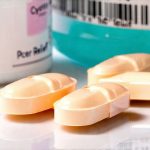Urinary tract infections (UTIs) are incredibly common, affecting millions of people each year – disproportionately women – and causing frustrating symptoms like burning during urination, frequent urges to go, and even abdominal discomfort. Because of their prevalence, many seek quick solutions, leading to a surge in popularity for over-the-counter (OTC) UTI pills marketed as alternatives to antibiotic treatment. These products often promise relief without a doctor’s visit, appealing to those seeking convenience or concerned about antibiotic resistance. However, the effectiveness and safety of these OTC remedies are complex and deserve careful examination; understanding what they actually do – and don’t do – is crucial for making informed decisions about your health.
The appeal of OTC UTI pills stems from several factors beyond mere convenience. Antibiotic overuse is a growing global concern, driving resistance in bacteria and diminishing the effectiveness of these vital medications when truly needed. Many individuals are hesitant to contribute to this problem or have had negative experiences with antibiotics in the past, causing side effects or failing to resolve their UTIs. This has created fertile ground for alternative solutions that seem to offer a gentler approach. But it’s important to recognize that self-treating a potential UTI can be risky, as symptoms can overlap with other conditions and ignoring a serious infection can lead to kidney damage.
What are OTC “UTI Pills” Actually Made Of?
The vast majority of over-the-counter products marketed for UTIs don’t actually contain antibiotics. Instead, they typically rely on one or more ingredients thought to support urinary tract health or address symptoms. The most common ingredients include: D-mannose, cranberry extract, and various vitamins like Vitamin C. D-mannose is a type of sugar that’s believed to prevent E. coli bacteria – the culprit in most UTIs – from adhering to the walls of the urinary tract. Cranberry extract contains proanthocyanidins (PACs), which are also thought to have anti-adhesive properties, though their effectiveness is debated. Vitamin C is included as an immune booster and may increase urine acidity, potentially inhibiting bacterial growth.
It’s vital to understand that these ingredients aren’t designed to kill bacteria like antibiotics do; they aim to prevent them from sticking around and multiplying. This can offer some symptomatic relief for mild UTIs, but it’s unlikely to eradicate a full-blown infection. Many products also include herbal blends with ingredients such as uva ursi or buchu leaf, historically used for urinary health. However, scientific evidence supporting the effectiveness of these herbs is often limited and concerns about potential side effects exist – particularly with long-term use. It’s crucial to read ingredient lists carefully and understand what you’re putting into your body.
Many OTC UTI pills are marketed as preventative measures rather than treatments for active infections, further complicating their perceived effectiveness. They may be helpful for individuals prone to recurrent UTIs who want to proactively support their urinary tract health, but they should not be relied upon as a substitute for proper medical care when symptoms arise. The concentration of active ingredients can also vary significantly between brands and products, impacting their potential efficacy.
Understanding the Limitations of D-Mannose
D-mannose is often touted as a natural alternative to antibiotics due to its ability to prevent E. coli adhesion. However, it’s not a perfect solution, and several factors limit its effectiveness. First, D-mannose primarily targets E. coli, which causes the majority of UTIs but isn’t responsible for all of them. Other bacteria can cause UTIs too, and D-mannose won’t have any effect on those infections.
Second, the amount of D-mannose needed to effectively prevent adhesion may be higher than what’s found in many OTC products. Studies demonstrating positive results often use significantly higher doses administered under medical supervision. – The bioavailability of D-mannose can also vary depending on factors like gut health and individual metabolism. This means that not everyone will absorb and utilize the supplement equally well.
Finally, even with adequate dosage and absorption, D-mannose isn’t a cure for an existing UTI; it simply helps prevent bacteria from establishing themselves. If an infection is already present, D-mannose alone may not be enough to resolve it without further medical intervention. D-mannose should be viewed as a preventative measure or potentially supportive therapy alongside conventional treatment, not as a replacement.
The Cranberry Controversy: PACs and Evidence
Cranberry extract has been a popular remedy for UTIs for generations, stemming from the belief that it acidifies urine and inhibits bacterial growth. However, the science behind cranberry’s effectiveness is surprisingly complex and often contradictory. The active compounds in cranberries believed to be responsible for UTI prevention are proanthocyanidins (PACs), specifically Type A PACs. These PACs are thought to prevent E. coli from adhering to the urinary tract walls, similar to D-mannose.
The problem lies in the variability of PAC content in cranberry products and the difficulty in ensuring sufficient intake for a therapeutic effect. – Many commercially available cranberry supplements contain very low levels of Type A PACs, rendering them ineffective. Furthermore, studies have yielded mixed results; some show modest benefits with high doses of standardized cranberry extract, while others demonstrate no significant difference compared to placebo.
Another issue is that the effectiveness of cranberries depends on several factors, including individual metabolism and the specific strain of E. coli causing the infection. Cranberry juice often contains added sugar, which can negate some of its potential benefits. The scientific evidence supporting cranberry’s role in UTI prevention remains inconclusive, making it a questionable stand-alone treatment option.
When to See a Doctor – Recognizing Serious Symptoms
While OTC UTI pills may offer temporary relief for mild symptoms, they are not a substitute for professional medical evaluation and treatment. It’s crucial to seek immediate medical attention if you experience any of the following: – Fever or chills – Back pain or flank pain (indicates potential kidney infection) – Nausea or vomiting – Blood in your urine – Severe abdominal pain – Symptoms that worsen or don’t improve after 24-48 hours of using OTC remedies.
These symptoms could indicate a more serious infection, such as pyelonephritis (kidney infection), which requires prompt antibiotic treatment to prevent long-term kidney damage. Ignoring these signs and attempting to self-treat can have severe consequences. A doctor can accurately diagnose your condition through a urine test and prescribe the appropriate course of action – typically antibiotics for bacterial infections.
Remember, early diagnosis and treatment are essential for preventing complications. Furthermore, recurrent UTIs should always be evaluated by a healthcare professional to identify underlying causes and develop a personalized management plan. Don’t hesitate to seek medical advice; your health is too important to risk with self-treatment based on unproven remedies.





















